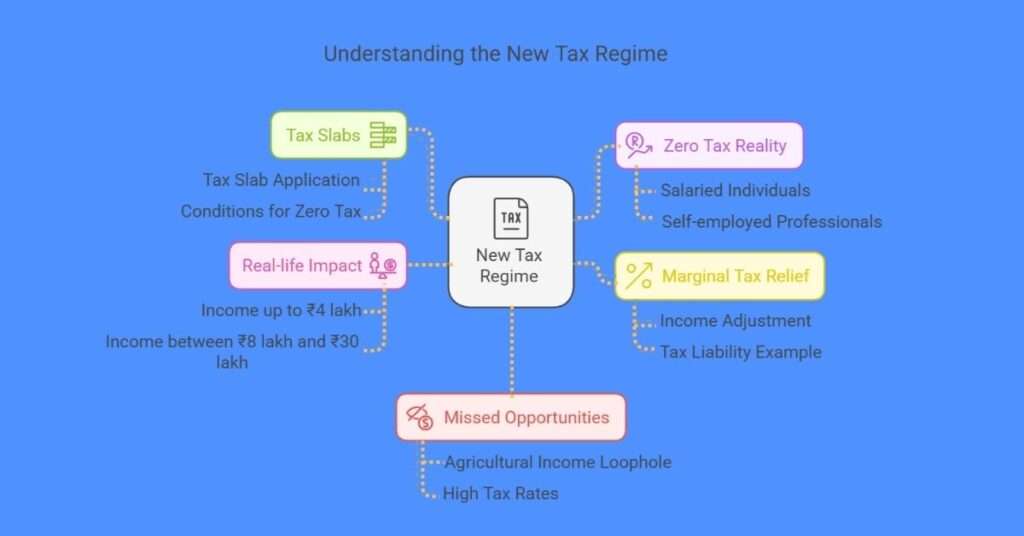The biggest news in Indian Budget 2025 that is making headlines everywhere is NO tax up to ₹12 lakh. But this is not the complete news. Because this depends on few conditions that we are about to discuss. let’s look at what are these conditions are and what conditions are applied to you.
In this year government is pushing the New Tax Regime more than the last year, making the Old Tax Regime more irrelevant.

Here is a breakdown of the key aspects of the Indian budget 2025:
Tax Slabs– The tax slabs under the New Tax Regime has changed. This is probably the most biggest change we have seen if few years. “No tax up to ₹12 lakh” is a misleading statement. Because this is the actual tax slab.
| Tax Slab | Income Tax |
| Zero to 4,00,000 | 0% |
| 4,00,001 to 8,00,000 | 5% |
| 8,00,001 to 12,00,000 | 10% |
| 12,00,001 to 16,00,000 | 15% |
| 16,00,001 to 20,00,000 | 20% |
| 20,00,001 to 24,00,000 | 25% |
| Above 24,00,000 | 30% |
- Zero tax Reality– Now the thing is, if you earn 12 lakh or less government will provide rebates that will effectively bring the tax burden to zero for self employed professionals or business owners. But for salaried individuals, the thing is little different. Salaried individuals will get 75k standard deduction. Which means if salaried individuals earn up to 12.75 lakh, they don’t have to give any tax. This 12 lakh threshold (12.75lakh for salaried individuals) does not include other income sources such as mutual fund, stocks or debt fund income. Those incomes will be taxed separately like LTCG and STCG in Equity.
- If a salaried individual earns even ₹1 more than ₹12.75 lakh, they will be taxed based on the above mentioned tax slabs. And in that case they have to pay taxed based on the applicable tax rated for different income brackets. For example , someone earning 12.76 lakh as a salary, tax is supposed to be calculated in the following way. You get 75k through standard deduction
- 5 % on 4 lakh – 8 lakh bracket = 4lakh * 5%= ₹20,000
- 10% on 8,00,001 – 12,00,000 = 4 lakh * 10 %= 40,000
- 1k left after the standard deduction is taxed 1k *15% = ₹150
- In the above example, increase of salary of 1K per annum leads to around 60k income tax and honestly this seems unfair. The government agrees. To avoid the above situation where someone earning just slightly more than the threshold level have to pay significant tax, the government has introduced the concept of marginal tax relief. In the simple terms, this adjust the income of those people who are slightly above the threshold level, such as reducing a ₹13 lakh income to ₹12.75 lakh, to ensure they do not pay more tax than someone just below the limit. This concept aims to reduce unfairness to some extent.
Real life impact

Some missed Opportunities
- Agricultural Income– Though Agriculture is a major part of Indian economy and most of the farmers are poor but the unlimited tax exemption on agricultural income can be seen as a missed opportunity. Specially because wealthy individuals including bureaucrats, politicians, actors and cricketers are exploiting this loophole to have huge tax free income. A practical solution would be to create a system that provides tax benefits to legitimate farmers while preventing exploitation by wealthy individuals claiming agricultural status.
- High Tax Rates– High tax rates may incentivized tax evasion. Once India had the highest tax of 97%, but it never helped Indian economy. Now it has come down significantly. Now it has brought down to 39% tax. Rationalising these tax rates may encourage honest tax payment and create a business friendly environment.
In summary, while the budget introduces some significant changes and offers benefits, such as tax savings across various salary brackets, it also highlights some loopholes, like agricultural income and the need for rationalized tax rates.
If you want to look at the full budget statement visit this link.
If you want to know how to increase your wealth do check out our investment blogs.